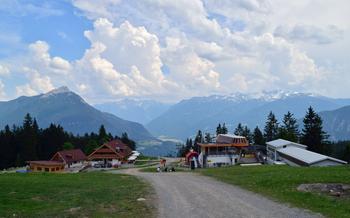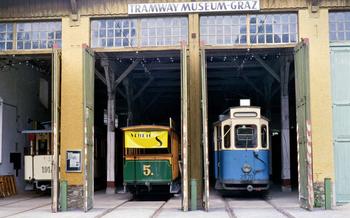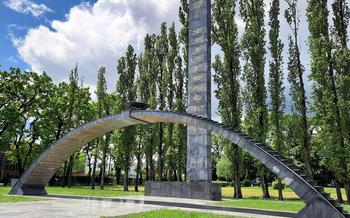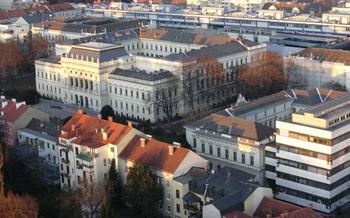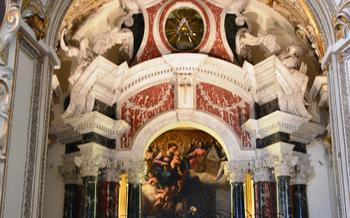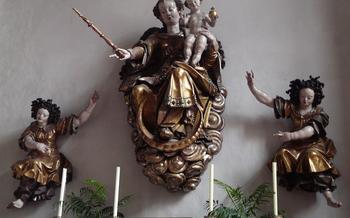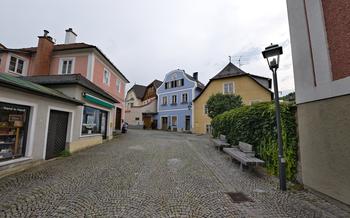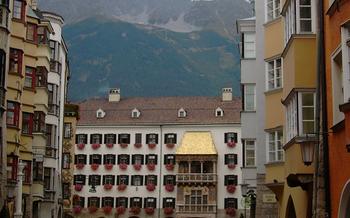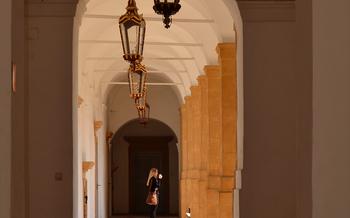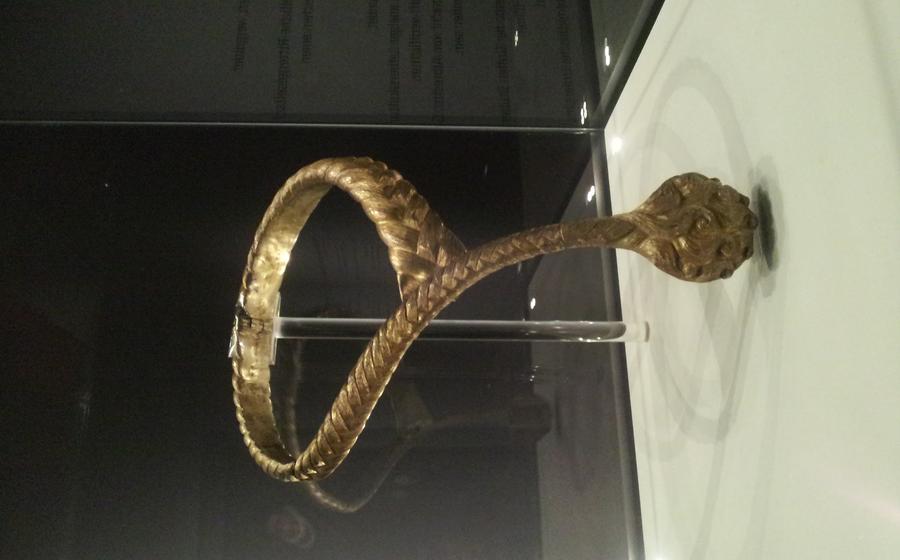
Museum im Palais
- Graz's Cultural Gem
- Diverse Collection
- Medieval Masterpieces
- Renaissance and Baroque Treasures:
- 19th-Century Romanticism
- Modern and Contemporary Art
- Temporary Exhibitions
- Educational Programs
- Museum Shop and Café
- Accessibility and Visitor Information
- Location and Transportation
- Hours of Operation and Admission Fees
- Guided Tours and Special Events
- Photography and Social Media
- Photography
- Social Media
- Insider Tip:
Graz's Cultural Gem
Graz, the captivating capital of Styria, is home to a plethora of cultural treasures, and among them stands the illustrious Museum im Palais. Nestled within the heart of the city, this grand edifice, known as Palais Herberstein, exudes an aura of elegance and history. Erected in the 16th century, the Palais served as the residence of the Herberstein family, one of the most influential noble families in Styria. In 1811, the Palais underwent a remarkable transformation, becoming the home of the Joanneum, a prestigious institution dedicated to art, science, and culture. The museum's inception marked a pivotal moment in Graz's cultural landscape, establishing it as a vibrant hub for artistic expression and appreciation. Today, the Museum im Palais stands as a must-visit destination for art enthusiasts, offering a captivating journey through centuries of artistic brilliance.
Diverse Collection
The Museum im Palais boasts a diverse collection of artworks spanning various periods and styles, offering a comprehensive journey through the history of art. The museum's focus on Styrian art is a highlight, showcasing works by local masters that provide insights into the region's rich artistic heritage. Among the notable highlights are the impressive collection of medieval armor, which transports visitors back to the era of knights and chivalry, and the stunning paintings by Peter Paul Rubens, a Flemish master whose works are celebrated for their vibrant colors and dynamic compositions. The museum also features temporary exhibitions that showcase contemporary artists, providing a platform for innovative and thought-provoking works that challenge traditional notions of art.
Medieval Masterpieces
The Museum im Palais boasts an impressive collection of medieval art, showcasing the artistic achievements of the Romanesque and Gothic periods. Among the highlights is the captivating 13th-century Madonna and Child statue, a testament to the exquisite craftsmanship and profound spirituality of medieval artisans. The intricate details of the Virgin Mary's garments and the tender expression on her face exude a sense of serenity and devotion. Another masterpiece is the Gothic altarpiece, a multi-paneled work depicting scenes from the life of Christ. The vibrant colors, intricate carvings, and expressive figures narrate biblical stories with remarkable skill and emotional depth. These medieval artworks provide a glimpse into the religious beliefs, artistic conventions, and cultural values of a bygone era, offering visitors a deeper understanding of the medieval world.
Renaissance and Baroque Treasures:
The Museum im Palais boasts an impressive collection of Renaissance and Baroque art, offering visitors a glimpse into the artistic and cultural developments of these transformative periods. Paintings, sculptures, and decorative arts from the 16th to 18th centuries adorn the museum's grand halls, showcasing the talents of Italian and Flemish masters, including Titian and Rubens.
One of the highlights of this collection is the museum's exceptional array of tapestries, intricately woven with biblical and mythological scenes. These tapestries, along with a remarkable collection of furniture from the same era, provide a vivid representation of the opulent and decorative style that characterized the Renaissance and Baroque periods.
Visitors can marvel at the exquisite craftsmanship of the furniture, adorned with intricate carvings and delicate marquetry, reflecting the height of craftsmanship during this era. The museum's collection of paintings from this period is equally impressive, featuring works by renowned masters such as Titian, whose vibrant colors and lifelike depiction of figures exemplify the Venetian Renaissance style.
Rubens, another artistic giant of the Baroque era, is also well-represented in the museum's collection. His dynamic and emotionally charged paintings, characterized by their dramatic use of light and shadow, offer a glimpse into the emotional and religious fervor of the Baroque period.
Through these remarkable works of art, the Museum im Palais invites visitors to immerse themselves in the grandeur and splendor of the Renaissance and Baroque eras, providing a deeper understanding of the artistic and cultural transformations that shaped this pivotal period in history.
19th-Century Romanticism
The Museum im Palais also houses a significant collection of 19th-century Romantic art. This movement, which originated in Germany and spread throughout Europe, emphasized emotional expression, individualism, and the beauty of nature. The museum's collection features paintings depicting idyllic landscapes, emotional scenes, and historical events, all rendered in the vibrant colors and dramatic brushwork characteristic of Romanticism.
Among the highlights of the collection are works by Austrian artists Ferdinand Georg Waldmüller and Friedrich Gauermann. Waldmüller's paintings often portrayed scenes of everyday life in the Austrian countryside, capturing the beauty of the natural world and the simple pleasures of rural existence. Gauermann, on the other hand, was known for his dramatic landscapes and animal paintings, which often depicted the untamed wilderness of the Alps and the Carpathian Mountains.
The museum's collection of Romantic art provides a glimpse into the artistic and cultural identity of Austria during the 19th century. It showcases the influence of Romanticism on Austrian artists and the ways in which they responded to the social, political, and intellectual changes of the time.
Modern and Contemporary Art
The Museum im Palais also boasts an impressive collection of modern and contemporary art, showcasing works by Austrian and international artists from the 20th and 21st centuries. These works challenge traditional notions of art, pushing the boundaries of artistic expression. Installations, sculptures, and paintings invite visitors to engage with new perspectives and ideas, sparking thought-provoking conversations.
The museum's commitment to contemporary art is evident in its dynamic exhibition program, which features both established and emerging artists. It collaborates with other museums and institutions to present innovative and thought-provoking exhibitions that explore a wide range of themes and artistic practices.
Through its focus on modern and contemporary art, the Museum im Palais plays a vital role in promoting and supporting contemporary artistic practices in Graz and beyond. It provides a platform for artists to showcase their work, fostering a vibrant and diverse artistic community.
Temporary Exhibitions
The Museum im Palais enriches its permanent collection with a diverse program of temporary exhibitions, showcasing works from different periods, styles, and cultures. These exhibitions offer visitors an opportunity to engage with a wide range of artistic expressions and explore new perspectives. The museum collaborates with other museums and institutions to bring these exhibitions to life, creating a dynamic and ever-changing cultural landscape.
Temporary exhibitions often focus on specific themes, artists, or movements, providing a deeper dive into particular aspects of art history. They showcase works from renowned masters as well as emerging talents, offering visitors a chance to discover new artistic voices and challenge their perceptions of art.
The museum's temporary exhibitions are not just limited to traditional mediums. They often incorporate interactive installations, multimedia presentations, and experimental forms of art, pushing the boundaries of artistic expression. These exhibitions encourage visitors to engage with art in new and interactive ways, creating a memorable and immersive experience.
Additionally, the museum uses temporary exhibitions as a platform to support and promote contemporary artistic practices. By providing a space for emerging artists to showcase their work, the museum contributes to the development and growth of the local art scene.
Temporary exhibitions at the Museum im Palais are constantly evolving, offering visitors a reason to return and experience something new. Whether you're an art enthusiast, a casual visitor, or simply looking for a unique cultural experience, the museum's temporary exhibitions are sure to captivate and inspire.
Educational Programs
The Museum im Palais is dedicated to fostering art appreciation and education among visitors of all ages. To this end, it offers a comprehensive range of educational programs and initiatives. Guided tours led by knowledgeable docents provide an in-depth exploration of the museum's collection, delving into the historical context, artistic techniques, and symbolism of the artworks. These tours are tailored to different audiences, including adults, students, and families, ensuring that everyone can engage with the art in a meaningful way.
Interactive exhibits and multimedia presentations further enhance the museum experience, making art accessible and enjoyable for visitors of all backgrounds. Through hands-on activities, digital displays, and audio guides, the museum encourages visitors to explore the artworks from various perspectives and gain a deeper understanding of their significance.
The museum also regularly organizes workshops, lectures, and artist talks, providing a platform for dialogue and exchange between artists, scholars, and the public. These events offer unique opportunities to learn about contemporary art practices, gain insights into the creative process, and engage in thought-provoking discussions about art and its role in society.
By offering a diverse range of educational programs, the Museum im Palais fulfills its mission of promoting art appreciation, fostering creativity, and inspiring future generations of artists and art enthusiasts.
Museum Shop and Café
The Museum im Palais houses a well-curated museum shop that offers a delightful array of souvenirs, art books, and reproductions. Here, you can find an assortment of items inspired by the museum's collection, ranging from postcards and posters to replicas of sculptures and paintings. Whether you're looking for a unique gift for a loved one or a special memento of your visit, the museum shop is a treasure trove of artistic delights.
After immersing yourself in the wonders of the museum's collection, you can unwind and recharge at the charming museum café. Situated within the museum's premises, the café offers a cozy ambiance and a delightful menu featuring an array of refreshments. Sip on a freshly brewed cup of coffee or indulge in a sweet treat as you bask in the tranquility of the museum's surroundings. The café also provides outdoor seating, allowing you to savor your refreshments while enjoying the vibrant atmosphere of the city.
Accessibility and Visitor Information
The Museum im Palais is committed to providing an accessible and inclusive environment for all visitors. Wheelchair ramps, elevators, and adapted restrooms are available throughout the museum, ensuring that everyone can comfortably explore the exhibitions. Audio guides in multiple languages and multilingual signage enhance the visitor experience by providing in-depth information about the artworks and the museum's history.
For further assistance or inquiries, visitors can contact the museum's friendly and knowledgeable staff. The museum's website offers comprehensive information about exhibitions, events, and accessibility features. It also provides practical details such as opening hours, admission fees, and transportation options, making it easy for visitors to plan their visit.
Location and Transportation
The Museum im Palais is strategically located in the heart of Graz, within easy reach of other cultural attractions, shopping areas, and restaurants. Situated in the historic center of the city, it is surrounded by charming streets, picturesque squares, and architectural landmarks. The museum's central location makes it a convenient destination for both tourists and locals alike.
For those arriving by public transportation, the museum is well-connected by several bus and tram lines. The nearest tram stop, "Jakominiplatz," is just a short walk from the museum, providing easy access from various parts of the city. Alternatively, visitors can take advantage of the city's extensive bus network, with several bus stops located within a few minutes' walk from the museum.
For those who prefer to travel by car, there are several parking options available in the vicinity of the museum. The nearby Jakominiplatz car park offers convenient parking spaces, while on-street parking is also available in the surrounding streets. However, it is essential to note that parking in the city center can be limited, so it is advisable to arrive early or consider using public transportation.
Hours of Operation and Admission Fees
The Museum im Palais is open to the public from Tuesday to Sunday, with varying hours on different days. On Tuesdays, Thursdays, and Fridays, the museum is open from 10 am to 6 pm; on Wednesdays, it is open until 7 pm; on Saturdays, it opens at 11 am and closes at 6 pm; and on Sundays, it is open from 11 am to 5 pm. The museum remains closed on Mondays and on certain public holidays.
Admission fees vary depending on the type of ticket purchased. A regular admission ticket for adults costs 12 euros, while a discounted ticket for students and seniors is available for 9 euros. Children under the age of 19 can enter the museum free of charge. Combination tickets are also available, offering discounted admission to the Museum im Palais and other museums in Graz. These tickets can be purchased at the museum's ticket counter or online through the museum's website.
Guided Tours and Special Events
Enhance your museum experience by joining a guided tour led by knowledgeable experts. These tours offer in-depth insights into the museum's collection, providing captivating narratives and historical context. Guided tours are available in various languages, ensuring accessibility for visitors from around the world. Advance booking is recommended to secure your spot, especially for groups.
The Museum im Palais also hosts a range of special events throughout the year, creating unique opportunities for visitors to engage with art and culture. These events include concerts featuring talented musicians performing in the museum's atmospheric galleries, lectures by renowned scholars delving into specific themes or artists, and family days designed to make art accessible and enjoyable for visitors of all ages.
To stay up-to-date on the latest schedule of guided tours and special events, visit the museum's website or inquire at the information desk. Don't miss the chance to immerse yourself in the captivating world of art and culture at the Museum im Palais.
Photography and Social Media
The Museum im Palais encourages visitors to capture and share their experiences through photography and social media. However, to ensure a respectful and enjoyable environment for all, certain guidelines must be followed.
Photography
-
Flash photography is not permitted in the museum galleries as it can damage sensitive artworks.
-
Tripods and selfie sticks are not allowed to prevent obstruction and ensure the safety of visitors and artworks.
-
Photography is prohibited in certain areas, such as temporary exhibitions or areas with restricted access. Please respect these restrictions to protect the integrity of the collection.
Social Media
-
Share your museum moments: Use the museum's official hashtags (#MuseumimPalais, #GrazMuseums) to share your photos and experiences on social media.
-
Tag the museum: Mention @MuseumimPalais in your posts to give credit and increase the visibility of your content.
-
Be respectful: Refrain from using flash photography, tripods, or selfie sticks in your photos. Respect the privacy of other visitors and avoid disturbing them during their visit.
By following these guidelines, you can help preserve the museum's collection, contribute to a positive visitor experience, and share your love of art with the world.
Insider Tip:
For an optimal visit to the Museum im Palais, plan your trip to coincide with off-peak hours, typically in the late morning or early afternoon, to avoid encountering large crowds and ensure a more intimate experience. Take advantage of the museum's free audio guide, available in multiple languages, to enhance your exploration and gain in-depth insights into the artworks.
While navigating the museum's collection, keep an eye out for hidden treasures that may not immediately catch your attention. For instance, discover the intricate details of the late Gothic altarpiece, a testament to the exceptional craftsmanship of the period. Don't miss the striking "Madonna and Child" sculpture, exuding a serene and tender aura.
To make the most of your visit, consider following a thematic itinerary. For art enthusiasts captivated by religious iconography, dedicate ample time to the museum's medieval and Baroque collections. Alternatively, if you prefer the emotive expressions of Romanticism, seek out the works of Austrian masters like Waldmüller and Gauermann.
By planning your visit strategically and embracing the museum's hidden gems, you'll unlock a truly immersive and enriching experience at the Museum im Palais.
